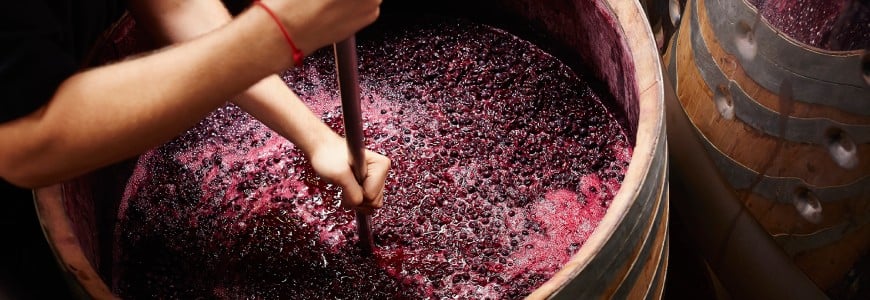New research has found that using alternative yeasts can be an effective way to reduce the use of sulfur dioxide in wine production. This is important because sulfur dioxide is a common additive in wine and reducing its use can have a positive effect on the health of those who consume it.
The study showed that non-Saccharomyces yeasts were able to effectively ferment wine without the need for sulfur dioxide, meaning this could be a viable alternative for winemakers looking to reduce their use of this additive.
The use of sulfites in winemaking is quite common as they are effective antibacterial and antioxidant agents. Sulfur-based products can also help protect against fungal diseases and other vermin in the vineyard. However, some people may be sensitive to sulfites, so alternative yeasts that don't produce them may be a better option.
Content
Sulfites and Bioprotection
Sulfites have a variety of effects on wine, from bleaching colors to reducing fruitiness aroma's. They can also be irritating to those who interact with them contact occur during the wine-making process. As natural wines become more popular, sulfites are increasingly viewed as negative.
There is a common misconception that sulfites are effective in preventing all bacterial and fungal growth in wine. However, this is not the case. Jeremy Leffert, director of winemaking for Tooth and Nail Winery in Paso Robles, California, is an advocate for bioprotection — an alternative approach that doesn't rely on sulfites.
Bioprotection is based on using naturally occurring yeasts to create an environment hostile to putrefactive organisms. These yeasts produce compounds that promote the growth of bacteria and fungi braking and thus protecting the wine against spoilage. This method has proven to be more effective than sulfites in preventing wine spoilage.
Yeast alternatives
The theory behind bioprotection is to encourage more microbial life at an early stage, as an active protection system. This is the opposite of using SO2 additives, which sterilize materials to eliminate microorganisms.
Laffort is a company that has been working on ways to reduce the use of sulfites in wine while fighting back against bacteria that can cause spoilage. They have selected a range of friendly microorganisms that can be added to grapes during pressing, or even before, to prevent the fermentations from derailing.
Daniel Dycus, the North American technical manager for Laffort, was working on the possibilities of using a wider range of yeasts in winemaking products when he received a call from a customer opening up new possibilities. The customer, Lorna Kreutz of Foley Family Wines, said her harvester often goes to volatile acidity smoke, meaning spoilage bacteria were present. This conversation led to new ways to fight the bacteria.
At Laffort, we believe in working with nature, not against it. This means that a selection of natural organisms are used to create a healthy environment for wine making. By doing this, we can avoid the use of sulfites, which can be harmful to both our wines and our customers.
Adding non-Saccharomyces yeasts to wine during production can lead to lower levels of acetic and lactic acid bacteria, as well as improve the mouthfeel and aromatics of the final product. This method was first studied at UC Davis with promising results.
Wine making equipment
Dycus and his team created a prototype "yeast blaster" that would spray a solution containing non-Saccharomyces yeasts onto winemaking equipment such as harvesters, igniters, presses, bins and trucks. They have now done four crops of experiments with different manufacturers in different countries, and more are joining in to compare the results of using SO2 with the Egide solution. The approach has yielded good results in studies and evaluations by winemakers.
Elizabeth Kester, director of winemaking at Wente Family Estates, started using Egide in 2014 when she saw an increase in stuck ferments in the cellar noticed. After some research, she discovered that the problem came from the vineyard and decided to use Egide as a solution. She found that it worked better than sulfur.
Using alternative yeasts can help replace sulfites in wines. This is especially helpful when transporting grapes over long distances, as the yeast can help prevent spoilage bacteria from growing.
The Swiss have found that having a wide variety of microbes on cheese rinds helps prevent the growth of dangerous pathogens such as Listeria and E. coli. The same concept can be applied to wine, using alternative yeasts to combat sulfites.
Using alternative yeasts can help replace sulfites in wines. The bioprotection approach follows the idea that if good yeasts take up more space, problematic elements can't take hold. This method can help to improve the overall quality of the wine.
Leffert explains that by using alternative yeasts you can delay the addition of SO2 much further. By 2021, Tooth and Nail wines eliminated SO2 additives in about 95 percent of the grapes. Most dental and nail wines do not see sulfur until bottling.
Scale and style
There is a lot of interest in using alternative yeasts to replace sulfites in wines from larger wine producers. This is because small batches of wine can be easily monitored for potential problems and adjustments can be made quickly. However, in large tanks of wine it is more difficult to spot problems early on and they can spread quickly, costing the producer a lot of money if he has to throw away a large batch of wine.
Winemakers wishing to avoid the use of sulfites can turn to alternative yeasts designed to promote healthy and diverse microbial life in the vineyard and winery. These yeasts can ensure that the fermentations run smoothly, with minimal variation from vintage to vintage. However, some winemakers may worry about losing control of the fermentation process when using these alternative yeasts.
It is essential for wine producers to have a consistent style across batches and vintages to maintain their brand identity. This is because customers have specific expectations of the wine they buy. Kester agrees that it is possible to make wine with natural ingredients, but states that it is difficult to achieve the same taste and style every time. This is due to the inconsistency of natural yeasts. Therefore, many producers rely on alternative yeasts to create a more predictable end product.
Some winemakers use alternative yeasts to replace sulfites in wines. This can be useful in small scale productions that would otherwise be fermented with natural yeasts. This method allows winemakers to take more risk while still protecting their product.
Taking bioprotection further
Laffort teams and wine producers are exploring the possibility of using bioprotection in the vineyard to protect grapes against schimmel to protect. Although not much data is available yet, the first indications are that bioprotection may be effective against fungi.
Leffert has started using a product called Khio, which is made from one of the yeasts in Egide. This yeast is selected from the native grape flora and forms a white film on the surface of the barrels before being released into contact come with grapes or bridge. This prevents more problematic yeasts from emerging.
Bioprotection could be an environmentally friendly way to replace sulfites in wines. It is a more efficient way to use water and can help improve the quality of wine.






